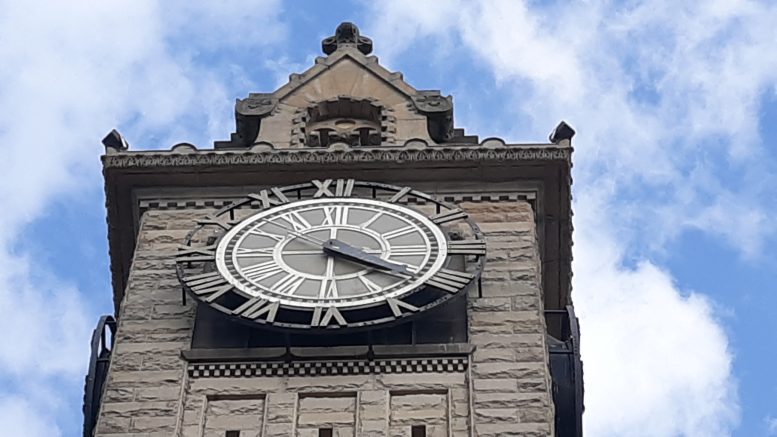By JAN LARSON McLAUGHLIN
BG Independent News
Like clockwork, local residents with mechanical minds have offered to try to get the Wood County Courthouse clock back on track.
Earlier this month, the 120-year-old clock in the 195-foot tall courthouse tower stopped. It’s by 4:19 ever since.
“It’s right twice a day,” Wood County Administrator Andrew Kalmar said.
But the county commissioners want the clock to be correct more than that. And apparently, many citizens share that desire to get the clock back in business.
Last weekend during the Bowling Green holiday parade, one man ran up to Commissioner Ted Bowlus’s car in the parade.
“I can obtain that piece,” Bowlus said the man professed.
Another man offered his millwright skills to Commissioner Craig LaHote. However, the man is 88 years old, and climbing up the steep stairs in the clock tower can be quite challenging, LaHote said.
“He said he was up there when he was 10 years old,” LaHote said.
Four different individuals have volunteered their mechanical skills to Steve Blausey, head of courthouse maintenance.
Time has taken its toll on the clock that rises high above Bowling Green. Even the majestic courthouse clock is bound to lose track of time when pigeons roost on its hands, when blizzard winds whip in its face, and when it works round the clock for more than a century.
Earlier this year, the clock seized up in the frigid February cold, blamed for breaking a pin in the clock mechanisms. The clock was back keeping time after a couple weeks when a new pin was located.
This time, though, the fix is a little more difficult since it involves a stripped gear – and replacements are no longer available. It’s not a typical gear, LaHote explained.
“It’s not like a regular round gear with teeth,” he said. Instead, it is cylinder shaped with diagonal gears.
“We’ve gotten offers from people to manufacture the pieces we need,” Commissioner Doris Herringshaw said.
“It’s kind of amazing how many people are concerned about the clock,” Bowlus said. “It’s iconic.”
“It’s a very visible landmark,” LaHote said.
“So changing it to digital isn’t an option,” Herringshaw said with a smile.
The clock motor is now at a Toledo company, where workers are trying to find a new solution for a very old gear.
“I’m confident we’re going to get this thing up and running,” Blausey said. “Everyone looks at that clock – round the clock.”
In early 2018, after several years of the Wood County Courthouse tower clock being behind – or actually ahead of the times – Kalmar talked with the courthouse crew about fiddling with the mechanism to get the clock to chime on time.
The commissioners’ office had gotten a few complaints over the years about the 195-foot tall clock running fast.
But once the clock was back on time, neighbors appeared to be finding it discombobulating.
It turns out some of the neighbors seemed to appreciate the advanced notice the courthouse clock had been giving them for decades.
Some Bowling Green residents had grown to rely on the early chimes, which acted as a giant snooze alarm of sorts.
Kalmar defended the timelessness of the courthouse tower clock, which is about 120 years old, running on a motor that is about 70 years old. Relying on it for exact time is asking for a lot.
“It’s a giant clock. It’s not like the cell phone in your pocket,” he said.
The clock has a storied history.
The story goes, according to the Wood County Auditor’s website, that when installed the clock had been guaranteed to vary no more than 10 seconds a month. But a few months after it was installed, a Bowling Green newspaper reported the clock “goes when it pleases and makes its own time.”
When constructed, the clock hands were the second largest in the U.S., exceeded only by the clock hands on the San Francisco Chronicle newspaper building. Stories vary, however, with some stating that the Wood County clock hands were 16 feet in diameter and some stating they were 17 feet. Either way, the San Francisco hands had them beat by half a foot.
The original hands of the clock reportedly were made of basswood – not of wrought iron as spelled out in the contract. The present ones are of aluminum.
The original basswood hands are now at the county historical museum. Many years ago the clock would be slowed by pigeons roosting on the hands. The clock used to be operated by a weight system, like a grandfather clock, but is now operated by a small motor.
The hands on the clock were reportedly frozen during the blizzard of 1978. A few years ago, one of the clock hands was wrestled by high winds and bent backward, Kalmar said.
“When the wind blows really hard, it catches those hands,” he said.
Each of the four faces of the clock has 12 electric light bulbs, one for each hour. To replace a burned-out bulb a steeplejack has to climb to the tower and then walk outside on a narrow ledge. The steps to the tower consist of three floors of steep stairs, followed by three steel ladders.
A little shanty just below the faces of the clock houses the mechanism. A huge arm with a sledgehammer on the end strikes the bell – which weighs 2,000 pounds.
The clock tower is frequently the home to a pair of nesting Peregrine Falcons, who often hatch a new batch of babies in the spring. The clock’s loud chiming – nor the lack of perfection in keeping time – apparently does not disturb them.


